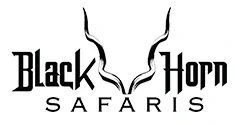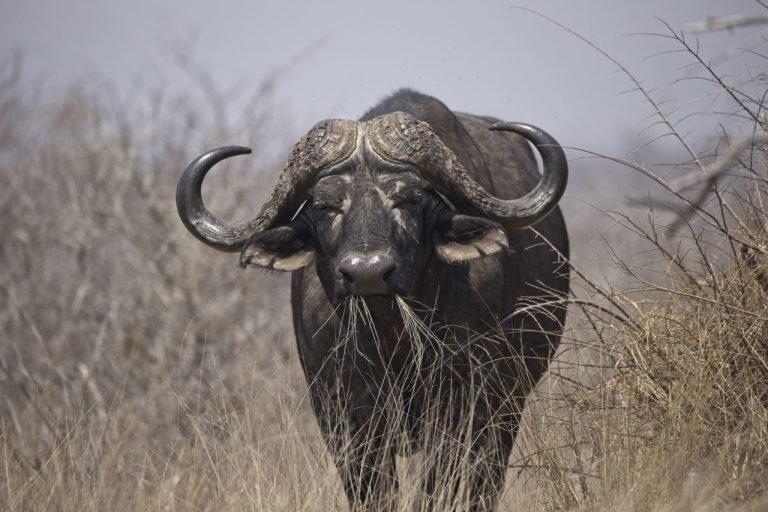
Also known as Africa’s Black Death. A title the African Buffalo has rightfully earned on many occasions. Famous for being incredibly tough, these thick skinned herbivores are what a hunters’ dreams are made of. The thrill of the chase combined with real danger is guaranteed to get your heart rate up, this is what hunting Buffalo in Africa is all about. Cape Buffalo is considered to fall under the category of Dangerous game, and for good reason.
Description of the Beast
The Cape Buffalo (Syncerus caffer caffer), standing with a shoulder height of 1.7 m, and mature bulls weighing in at around 800 – 900 Kg. A bad temper to match his reputation to charge without warning, these bovines will ensure a hunting experience never to be forgotten. buffalo are grazers, which means they eat mostly grass. They are typically herd animals and can travel in herds ranging from 10 to 1000 Buffalo in The Kruger National Park and Zimbabwe. Trophy bulls will have solid boss horns spanning from 38 – 44 inches but trophy quality can vary. The biggest trophies have come from Tanzania. The Rowland Ward world record buffalo is 91 5/8 inches “gross total.
The old hard boss bulls, better known as Dagga boys, from the Zulu word ‘dagga’ meaning mud, usually travel by themselves or in small groups with other old males. And have a notorious reputation of always being mean tempered. The old males are known for wallowing in mud holes to cool down and sooth their skin. As well as covering themselves in a thick layer of mud to protect their skin. Because Cape Buffalo experience hair loss, the mud is thought to prevent sunburn, relieve itchy skin and rid the body of parasites.
Robert Ruark once wrote that the African Buffalo looks at you as if you owe him money. This is accurate, if not, an understatement of old solid boss bulls. An old male is one of the meanest critters you can encounter on an African safari, they are dangerous animals, and can be extremely aggressive. Buffalo have a very thick skin, covered with a coat of course black hair. The older Dagga boys lose their hair with age and start to appear lighter in colour. Both male and female buffalo have horns, however the males have much bigger and wider horn bosses and generally wider and thicker horns.
The buffalo cows are slightly smaller, weighing in at around 700kg. Many hunters choose a buffalo cow to gain the experience on buffalo, without the price tag associated with hunting a trophy Cape Buffalo. Buffalo have a lifespan of around 18-20 years. Young males, have soft horn bosses, hence their name of “soft boss bulls”. At around 8 years old, these horn bosses become hard and these hard boss bulls generally stay with the family herd until breaking off into bachelor herds.
It is still possible to hunt free range African Buffalo in South Africa in the associated private nature reserves that adjoin the Kruger National Park however the trophy fee is significantly higher than other parts of the country as are plains game in these areas. One of the best places for buffalo is the Limpopo province.
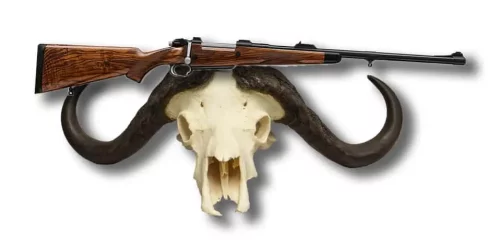
Cape Buffalo Hunting Rifle and Caliber Choices
As long as man has hunted the Cape Buffalo there have been many a debate, and there will continue to be many debates, about caliber choices for Africa’s Black Death. The South African regulations requirement for hunting Buffalo is .375 caliber rifle or larger. Many people believe such a big caliber is not necessary for big game. Others again claim that it is not big enough. From my personal experience, I would say that the minimum caliber requirement is in place for good reason. On Cape Buffalo in Africa I have seen them run great distances with a well-placed .375 shot. I have also seen big bulls crumple at a well-placed shot with the same caliber and not go far, allowing for a quick follow up shot.
Bigger rifle calibers have more recoil, and often hunters are not used to the recoil of the larger calibers as they have no need for them when hunting back home. The unaccustomed recoil of the bigger rifles can result in a flinch and a shot that is not placed so well. It is the general consensus that the bigger the caliber, the bigger and heavier the bullet weight, the bigger the resulting wound channel. Which in turn leads to better and more devastating results and a larger margin for error on the shot. This can only be a good thing. In essence, I would rather have a well-placed shot with a .375 than a poorly placed shot with a .600 Nitro Express. Make the first shot count.
However I would prefer to have a well-placed shot with a 416 Rigby over a well-placed shot with a 375 or other marginal caliber. There is no substitute for shot placement on African Buffalo. A best quality premium grade bullet is also vitally important. The best rifles and calibers for Buffalo are the 416, 458 Lott, 470 Nitro and 500 Nitro.
Rifle Scope Choice for Cape Buffalo
With regards to the rifle scope, I would recommend a low magnification variable scope, such as a 1-6 or a 1-8 variable power rifle scope. These variable rifle scopes offer the best and most practical alternatives. They allow you to make the first shot on a higher magnification, usually 4x or 6x and then allow you to dial the magnification down to 1X for the follow up shot. There is no need for a real high magnification scope on a safari as your usual shooting distance will be within 80 meters and often much closer.
Open sights are not advisable for the first shot, unless you are very comfortable with your rifle and can consistently shoot well out to distances of 100 m. However on Safari open sights are perfect for the follow up shot, possibly on a moving target. I would recommend that your riffle scope be mounted on a quick detach system so that the scope can easily be removed if needed for the follow up shot.
Bullet Choices for Hunting in South Africa

The bullet is the only part of your rifle setup that actually has contact with the Cape Buffalo. A hunting safari can result in a really bad experience through the use of poor quality bullets on a buffalo in South Africa. A poor-quality bullet may shatter on impact resulting on poor penetration which will not have any lethal effect on a buffalo. Resulting in a dangerous situation for all involved in the Cape Buffalo safari. You may also end up losing the buffalo trophy completely and paying the full trophy price and going home empty handed. Never try to save a few dollars on poor quality bullets. You may waste a lot of money by using poor-quality bullets on a Buffalo safari. Some of the best bullets are manufactured by Swift, Barnes, Trophy Bonded and Nosler.
Ideally, you want a premium quality bullet that will retain most of its original bullet weight. Such a bullet should mushroom open to cause a large wound channel and still offer superior penetration that you need to reach the vitals. Make sure you contact your P H before the Cape Buffalo safari in Africa and ask what bullets he recommends. If you are bringing your own hunting rifle and ammunition, make sure you bring enough ammunition!
The Back Up shot is a sensitive topic to most but I believe that it should be discussed when you pursue dangerous game. It is fully understandable that someone does not want another person shooting their animal when Buffalo hunting in South Africa, which could possibly be the case. However, the Professional Hunter has an obligation to protect the client, himself, the tracker and anyone else along on the safari. Therefore, if a dangerous situation should arise, the P H will exercise his discretion and shoot. Such a necessity could arise if the situation turns dangerous or if the guide sees that the shot is badly placed or in the last few hours of sunlight on your final day.
Ultimately, it is up to the hunter on this matter unless a dangerous situation exists. However, in a dangerous situation the P H will be obligated to intervene and safeguard his clients and staff.
The Back Up Shot on a Trophy Cape Buffalo
The Back Up shot is a sensitive topic to most but I believe that it should be discussed before setting out. It is fully understandable that a person does not want another person shooting their Buffalo, which could possibly be the case. However, the P H has an obligation to protect the hunting client, himself, the tracker and anyone else along on the safari. Therefore, if a dangerous situation should arise, the professional guide will exercise his discretion and shoot follow-up shots if necessary. Such a necessity could arise if the situation turns dangerous or if the P H sees that the shot is badly placed or in the last few hours of sunlight on your final day. Ultimately, it is up to the hunter on this matter unless a dangerous situation exists. However, in a dangerous situation the P H will be obligated to intervene and safeguard his clients and staff.
Cape Buffalo and Shot Placement
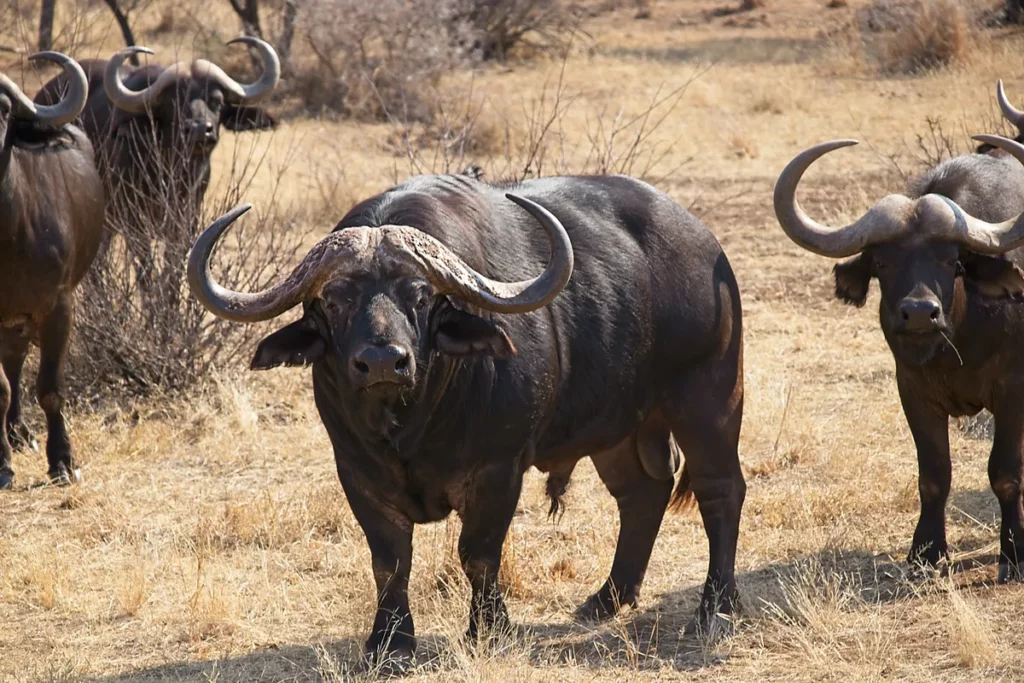
While hunting dangerous game where your shot is placed is tremendously important, especially in a large herd. The shot on Cape Buffalo may require some variation, and consideration needs to be given to a number of factors. On African hunts where the shot is placed on wounded buffalo can differ from un-wounded buffalo depending on the situation.
Typically, you would want a broad-side shot, with no other Buffalo behind your target animal. The last thing you would want is over penetration and the bullet going through the trophy buffalo and wounding another animal on your safari. This could make your hunting safari very expensive and twice as dangerous.
Therefore be mindful of the caliber and type of bullet you are using, most soft point bullets in the generally used calibers will not exit on a broadside shot. However there are a few that will. If the buffalo is not standing broadside, the guide may ask you to place a quartering towards or quartering away or frontal shot. This is not uncommon and these shot angles should be lethal when pursuing African Buffalo.
The vitals of a Cape Buffalo lie in the fore quarter of the animal, between the two shoulders and in the bottom half of the buffalo. On Buffalo good shot would be on the shoulder if the buffalo is broad side, hoping to break the shoulder blade as well as penetrating both the lungs and the heart. This placing the shot here will be lethal and will minimize the risk of a charge from the buffalo.
In the really big herds in southern Africa, often a frontal shot will have to be taken to ensure the bullet does not exit and hit another animal behind it. Sometimes it will be impossible to get a shot with no other Cape Buffalo behind the one you would like to shoot. Should the Buffalo decide to charge, you have no choice but to hit the brain or the spine in order to stop the charge. Even a well-placed frontal heart shot will not stop a Buffalo charge in sufficient time to prevent a member of the hunting party being injured.
The brain lies just beneath the horn bosses and a shot here will be instantly lethal. Should the buffalo be wounded, and if it is running away, a rear end shot should be taken. In which case the hunter aims to break the spine or to penetrate through the rumen and reach the vitals. There are many pictures on the internet illustrating where to place the shot on a Cape Buffalo. Where to place the shot is something that should also definitely be discussed with your P H before the start of your hunt.
Boots For Walking after Mbogo when Buffalo Hunting
It has been said that you kill a Cape Buffalo with your feet when Cape Buffalo hunting in South Africa. A good piece of advice, is to wear comfortable well fitting boots. There is usually a lot of walking involved in trophy hunting in Africa and sore feet and blisters take the fun right out of the hunts. Do not wear new boots for the first time on an African hunting safari.
Many a hunter has bought new boots for their safari to Africa and worn them for the first time on their first day of the safari only to experience pain and limited mobility. The risk of the boots hurting you is not a risk I would advise you take. Make sure you are confident and comfortable with your boots and ready to walk a good distance in them.
Fitness For Hunting
A good piece of advice is to make sure that you are fit enough and ready for the walking involved. A bit of fitness training before your Buffalo hunt will take place can only do good and prepare you for the hunts of your life. Comfortable clothing should also be worn during hunts, South African winters are pretty cool in some areas, but temperatures can vary throughout the day.
Certain places in Africa it can be freezing cold in the early morning, then hot in the midday, then back to cold in the evening and night time. You should consult your hunting Outfitter on the temperatures you can expect during your hunt, and pack accordingly.
Also take into consideration that most of bushveld is covered with thorn trees, which tend to rip and tear clothing, jackets and shirts in particular. The common perpetrator being the infamous wait-a-bit thorn tree which has hooked thorns, and if you are not paying attention, will hook and hold you. This requires you to take each thorn out individually and can take some time, hence the name of wait a bit thorn tree.
A good hat combined with sunblock is also advisable on hunts as the African sun burns skin quickly and sleepless nights, caused by heatstroke or discomfort due to sunburn is not something you want on your Buffalo safari. Something else to remember is to make sure that you stay very well hydrated on hunts!
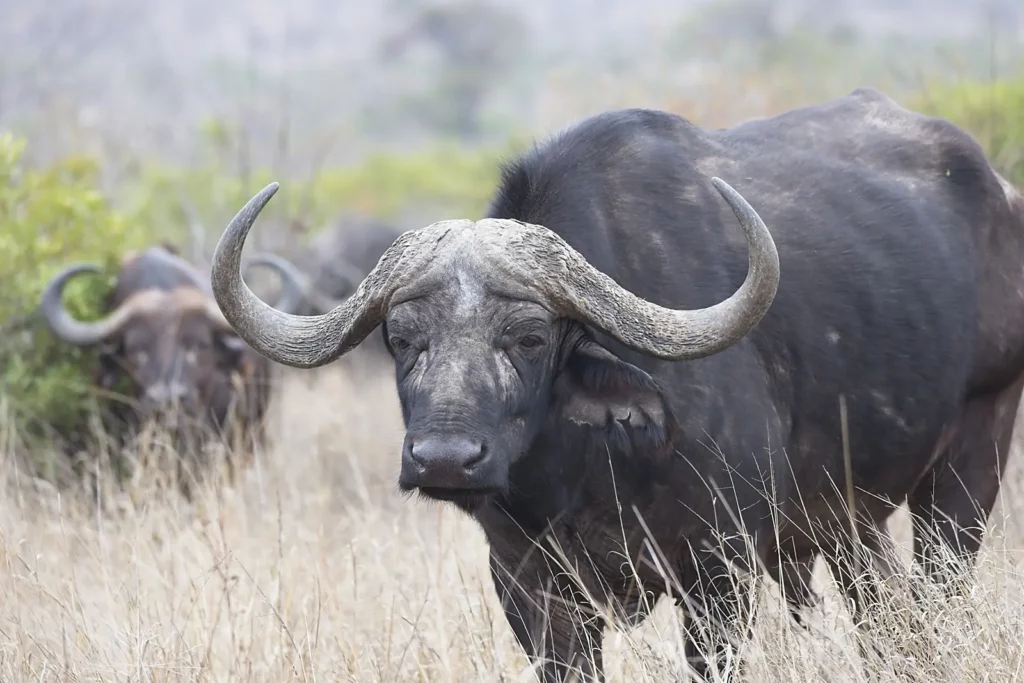
Hunting Safari in South Africa
Typically Cape Buffalo on a hunt in South Africa will start at a waterhole after an early breakfast, as buffalo are very water dependent and drink up to 40 liters of water at a time. The guide and tracker will search for fresh tracks in the mud. If there are some fresh tracks that look like they could belong to a big buffalo bull, the hunt is on. You will follow these tracks on foot, sometimes for a number of hours. You may see where the buffalo has rubbed mud or his bosses on a tree, usually damaging the bark quite a bit.
If the buffalo are in a herd, you will see lots of buffalo pats along the track. If it is a single old Dagga boy, you will come across the droppings somewhere along the track, but obviously not as plentiful as a herd would leave. These can be checked to verify the freshness of the track. If the pat is still green and soft, it is very fresh. As time presses on, the droppings will form a crust around it, keeping the inner dropping soft. If this is the case, the buffalo are not too far ahead and the tracks are definitely worth pursuing.
If the dung beetles have started dissembling the pats and the droppings are semi-hard all the way through, chances are the buffalo have a good lead on you but you may still catch them. If the droppings are stone solid, the tracks are generally not worth following. If the droppings are warm and steamy, you are very close! Time to be extra vigilant and cautious.
The Importance of Ox Peckers
While after Cape Buffalo the ox-pecker bird can be your best friend or your worst enemy in the hunting area. This bird has a symbiotic relationship with the buffalo, and peck ticks and other parasites off of them in the national parks. You know you are close when you hear the “CHIRRRRR-CHIRRRRR” of the ox-peckers. This sound can warn the buffalo of your presence, but also helps you locate the buffalo in thick cover in Africa. This is normally where the adrenaline picks up and the stalk slows down and you must be extremely quiet. A buffalo does not have the best eyesight or hearing, but has a very keen sense of smell. To have wind in your favor is vital for hunts.
A typical Cape Buffalo’s day will include some walking, grazing, and drinking water after which he beds down to chew the cud in wild Africa. When they bed down, this is often the state they are in when you find them. The herds will always have sentries posted on the lookout for predators, often rotating the watch. The old Dagga boys are often more difficult to locate as they are solitary or in small bachelor herds in South Africa. The upside is that because there are fewer eyes and ears they are easier to stalk to within range. Bearing that in mind, old Buffalo did not get old through being stupid. Where they lack the herds eyes, they make up for in bad temper and brains.
Spot and Stalk
Once these Bovines have bedded down, and you have established where the old Dagga boy, or the herd is, the stalk becomes very slow and quiet. The P H will need a moment to evaluate the trophy quality. Crawling on your hands and knees or leopard crawling are common activities in the final minutes of the stalk. Checking the wind often is a must, as if the wind turns towards the buffalo, all you will see is a cloud of dust and hear the thunder of hooves. This will probably happen a number of times before you are ready to take the shot and the shooting sticks are setup. The excitement that pumps through you on the final stalk can not be compared to any other hunt you have experienced. You are stalking up to a species that has killed many hunters in Africa. A species that does not hesitate to kill a full-grown Lion. A species that has the ability to retaliate against buffalo hunters. A species that you are hunting on their terms. This is exhilarating hunting.
Cape Buffalo – Where to shoot when Hunting in Africa
After the final stalk, and you are up on the shooting sticks looking through the scope, even the most experienced hunters get the shakes as adrenaline kicks in. If you are shaking all over the place, do not take the shot. On Hunts don’t focus on the recoil of the rifle, you won’t feel it when the shot breaks. Make sure you have a clear shot without twigs and grass to knock your bullet from it’s flight path.
Focus on where your cross hair is supposed to be and slow your breathing, then squeeze the trigger and wait for the shot to break. If the Buffalo is alone, try to reload as fast as you can for a follow up shot. Note that a follow up shot is extremely risky in herds and you don’t want to shoot and wound another buffalo. After the shot, if it is a well-placed shot, you can wait and listen for the death bellow of the Buffalo. Sometimes the buffalo does not give the death bellow, and then you will have to track it.
If the P H did not see where the shot impacted the Cape Buffalo, you can judge where it has been hit by taking a look at the blood left on his trail. A light frothy blood means a lung hit, which is a great shot and may not require follow up shots.
Bright red blood indicates bleeding from arteries. Darker blood indicates bleeding from veins. If there is a greenish colored or clear fluid present, this usually indicates an intestinal shot. You can also look at the height of the blood on the surrounding trees and bushes that the buffalo brushed up against and get a good idea of the height of the shot.
After the Initial Shot on a Buffalo Trophy
If you walk along the track and see that the Cape Buffalo has been hit with an intestinal shot, or know that your shot has not hit a major vital, the real danger begins. You now have a wounded buffalo to deal with. Do not be upset by this, even the best sportsmen can wound a Buffalo.
These are incredibly tough animals. At this point, you may want to consider asking anyone who is not a guide or essential staff to stay behind during the follow up hunts. This is an extremely dangerous situation and you don’t want to add extra bodies to look after. The hunter may become the hunted on these dangerous game hunts.
Should you find the buffalo lying down with its head up, try get behind it and place another shot between the shoulder blades and break the spine. This will anchor the Buffalo and ensure a quick death and no charge. If it is lying with its head flat, some guides will insist you put in another shot for insurance. After all, it is the dead ones that kill you.
When Things get Hairy
The follow up on a wounded Cape Buffalo is normally extremely slow with plenty of stops and starts by the two tracking staff. You will walk a bit, then stop. Listen carefully. Try to listen for his breathing. Try to hear him if he’s coming towards you. Listen to the quite of the bush, knowing that there is an angry buffalo, with a dangerous reputation, that could be anywhere around you. Make sure to check behind you.
Wounded buffalo have been known to circle around on their track and wait to ambush the hunters. When you have a wounded Buffalo to deal with, you must remember that your life is in the hands of the professional guides and the tracking staff. That is why it is imperative to have an experienced P H with a good tracking guide on the hunt when after Buffalo.
Insurance Shot – Pay the Insurance
When the wounded buffalo is found, and the situation allows it, the hunting client will place a follow up shot. If, however, the buffalo charges when found, the P H will have to shoot along with the hunting client. A charging Cape Buffalo can only be stopped with a brain shot or a spinal shot. These are very small targets when you have an animal the size of a small car coming at you with speed and the intent to kill.
Don’t Kill the Hunting Guide
One thing to be very mindful of when things get hairy on safari, is that you do not shoot the P H or or any of his staff. This does happen on occasion, normally when the situation turns intense and you are under stress and can hear the buffalo on his way to come and give you a piece of his mind. Be mindful and only pull the trigger if you are 100 percent certain of where that bullet is going. Remember that it is the PH’s obligation to protect you during a dangerous situation and he will do his utmost to put the Buffalo down on hunts.
Buffalo Hunt – The Bull is Down
Once the buffalo is down and your insurance shot is in, the guide may approach the buffalo from behind and use the end of his rifle barrel to touch the eye of the buffalo. If he blinks, shoot him again. If not, let the celebrations begin!

Hunters Photographs
Take the time to take great pictures and take as many as you can, this is the only thing you will have to remember the hunt by, as it will be some time before you receive the mounted trophy. If the trophy is damaged or lost or withers with time, you will always have the photographs of your most exciting hunt to stir your memory. Store the pictures in a safe place when you get home.
Everything in this day and age is digital, so it is easy to keep them safe without taking up any space. Also ensure the photos are taken with a good camera. Every good guide will have a good camera with high resolution which allows for excellent pictures. Decide whether you want to blow up a few of the pictures and print them on canvas or keep them on your computer. Keep a few photographs to brag to your friends and send them pictures from your phone. Pictures are a vital part of trip and should never be rushed or overlooked.
A Change of Perception After Cape Buffalo Hunts
Hunting the Cape Buffalo – this magnificent beast may ruin your perception of what other hunts are meant to look and feel like. Once you feel the adrenaline and excitement of pursuing a buffalo, a deer hunt or boar hunt may never feel the same again. Life is too short not to hunt at least one African Buffalo. Use Enough gun, Shoot straight and enjoy your hunt.
Cape Buffalo Hunting Package and Prices
A Buffalo will cost $ 9 100.00 for the trophy fee and $ 450.00 per day for a 7 to 10 day hunt. The total price to hunt a Buffalo Is $ 12 250 or a 7 day hunt all inclusive for a buffalo up to 38 inches.
A Buffalo hunting package for a 7 day hunt all inclusive is $ 13 550 for a Buffalo up to 41 inches.
These prices include:
- Accommodation and Meals
- The services of a Professional Guide
- Skinning and field preparation of your animals
- Road transportation to and from Johannesburg International Airport
Remember to add plains game to your hunting safaris while you are on your African safari, prices are reasonable and it’s worth doing.
Bow Hunting Cape Buffalo in Africa
Bow hunting Cape Buffalo is possible with the correct archery setup. The minimum requirement for Bow hunting Cape Buffalo is 80 ft/lbs of kinetic energy. You will require a final arrow weight of around 800 gr tipped with a fixed blade broad head that has two cutting surfaces to get sufficient penetration to reach the vitals of a Cape Buffalo on hunts. Grizzlystik manufacture excellent arrow shafts and broad heads that fit this purpose. A Buffalo requires the best possible archery equipment to be successful. The ideal Bow Hunting setup for Buffalo requires careful consideration, don’t get it wrong.
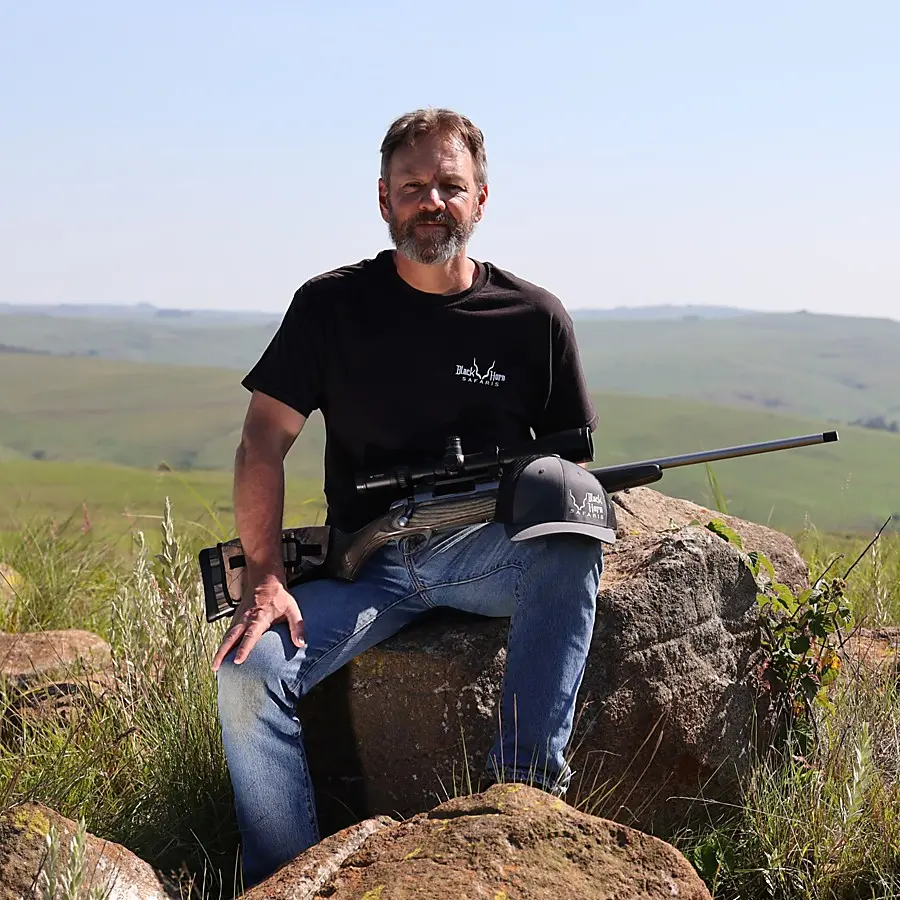
Adrian Anderson first obtained his Professional Hunters license in 1991. He is a Big Five and Dangerous Game licensed Professional Hunter and Hunting Outfitter. He has a tremendous love for wildlife and the African bush and enjoys sharing his knowledge with the hunting clients that he guides. Guiding hunters in Africa’s wild places is a passion and seeing them succeed with their goals brings satisfaction. With knowledge of the Safari industry built up over 32 years he is well qualified to give guidance to his hunting clients.
